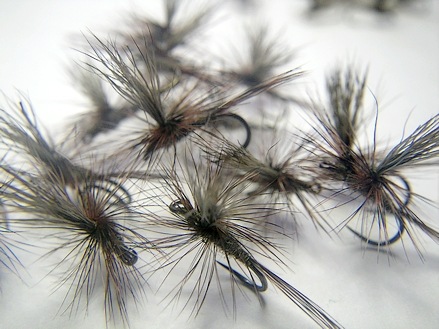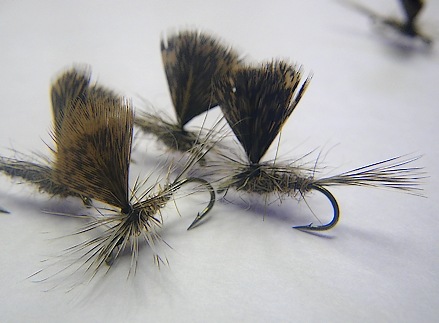The last piece of my stillwater arsenal has to be the dry flies. All are custom patterns I keep tinkering with as shortcomings and frailties become pronounced. The Calibaetis mayfly doesn’t help much as it’s seems to be a different color on every lake it inhabits.
I like to position myself on the side of the lake the wind blows towards – as the emergent adults are content to ride the breeze for great distances – instead of popping off the water immediately like a stream borne insect. The breeze will deliver all that food right to me and in the right bay or shallows the fishing can be spectacular.
For most lake mayflies I’ll toss the classic proportions and make special flies tailored for an extended float. A traditional size 16 will get the wing and hackle of a 15 (sometimes even larger if the lake is known gusty) – as the tall wing is what fish see when cruising for prey.
… and it allows me to pick my fly out from the pack, allowing me the courtesy of setting the hook when it’s eaten – rather than yanking when it’s the natural next to mine … On breezy lakes, the tall wing allows me to maintain visual contact despite the fly dipping into a wave trough – increasing my chances of seeing the strike.
I cast about two thirds less than the average fellow, as once positioned on the windward side I’ll usually find the fish cruising at my feet. As that ever-present breeze blows my “sailboat” back towards me I’ll slowly take up the slack and recast only when the fly is within a rod’s length.
It’s flirting with bait fishing, but that extra breadth of hackle and light dressing allows a greased fly to float forever.
I’ve settled on both brown and a grey bodied flies for the same hatch. One will have a distinct brownish appearance, the other will be tied mostly gray – and as the emergence is midday – there’s ample light to discern color. I’ve given up theorizing or second guessing and just make sure I have a couple dozen of each.

The nymph is the easiest part; somewhere between a Pheasant Tail, a Gold Ribbed Hare’s Ear, and a Zug Bug is the proper flavor, and like the dry fly it varies a bit each year.

I like the speckled hen saddle wings as they present the perfect opaque silhouette, and when riding among naturals are nearly indistinguishable. Note the oversized wing and hackle mentioned earlier. Once damp those wings can overpower a traditional hackle and flop the fly on its side. The broad footprint of the oversized hackle stabilizes the fly and ensures it’ll ride upright with wings prominent.
All these unknown experimental made-it-yourself flies comes with a hideous burden, after the fellow next to you inquires and you tell him to “try an Adams” – you’re obliged to hand over a double-fistful, it’s the law.
Tags: Adams, stillwater dry flies, oversized wing, speckled hen saddle, Calibaetis mayfly, parachute flies, hairwing, dyed elk, grizzly hackle, fly tying

Any line twist issues with those hen wing callibaetis?
Not so’s I notice. The hen isn’t rigid at all and I’m using tippets of 5x or 6X. I don’t usually get to go smaller.
You tie a damn nice fly Keith.
Those look better than anything in my box! Damn.
What hooks did you use.
The hairwing parachutes are tied on a Knapek barbless trout hook (size 16). The hen saddle tip flies are tied on standard Tiemco 100’s, also size 16.
I’m testing the Skalka, Knapek, Grip, Hanak, and Dohiku dry fly hooks – and spent much of the winter retying all of my fly box with these competition hooks.
Ditto for much of the underwater stuff. I have many of the flies shown in the last three posts tied on eastern bloc hooks – just to test the hooking quality and rigidity of their iron.
The J. Fair flies are on the ancient mustad iron from ebay, the #4450 (ring eye, 2X strong) – and the Damsel nymphs are on the 234B short shank, reversed, 2X strong Mustad from the same source.
Yup I got in on some of that ancient iron. I bought some 234 hooks.